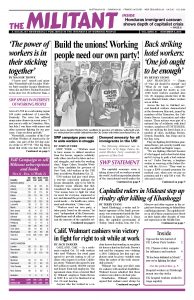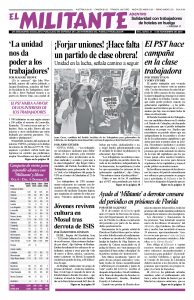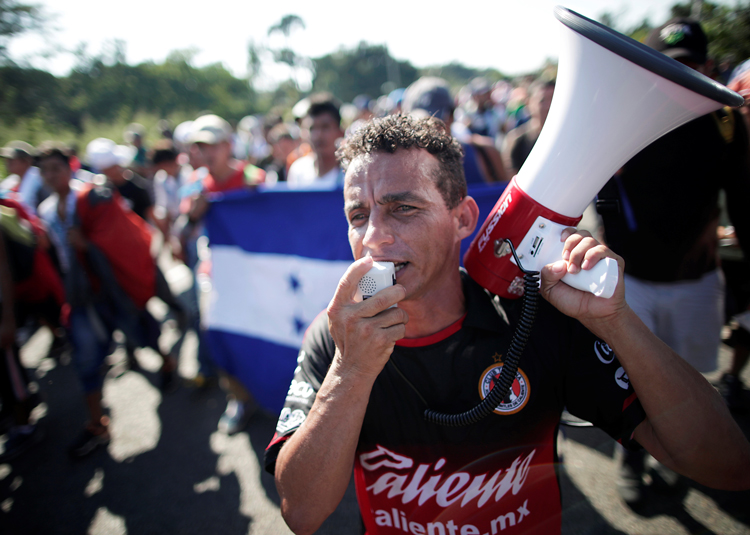Thousands of Hondurans, overwhelmingly workers and farmers, have traveled through Guatemala into Mexico, and are making their way toward the U.S. border, hoping to enter the United States with or without permission of U.S. authorities. The size of the caravan, many times larger than similar ones over the past decade, is a sign of the deep capitalist economic and social crisis in Honduras and Central America.
President Donald Trump is trying to take advantage of the caravan to advance his efforts to increase the capitalist rulers’ control over the pace and flow of immigration, including to force Congress to fund fortifying the wall at the border, and increase divisions among working people. When you look at the caravan, he tweeted, “blame the Democrats for not giving us the votes to change our pathetic Immigration Laws! Remember the Midterms! So unfair to those who come in legally.”
He demanded that the governments of Honduras, Guatemala and Mexico stop the caravan — which he claimed included criminals and Middle Eastern “terrorists” — and send its participants back home, or face a cutoff of U.S. aid.
The caravan was initiated in San Pedro Sula, Honduras, Oct. 12 by Bartolo Fuentes, a former congressman from the Libre Party, the main capitalist opposition party in Honduras. The party is headed by Manuel Zelaya, who was ousted as Honduran president by the military in 2009. Fuentes accompanied the marchers into Guatemala.
U.S.-based Pueblo Sin Fronteras (People without Borders) is helping to organize the 1,400-mile caravan.
The Democratic Party — from liberal establishment officials like Nancy Pelosi to so-called radicals like Democratic Socialists of America member Alexandria Ocasio-Cortez — have maintained a wall of silence on the issue. Convinced that most workers are reactionary, they fear that Trump’s use of the issue might aid Republican candidates in the midterm elections.
But liberal newspapers have featured the caravan on their front pages — hoping that the images of suffering women and children would embarrass the White House and rouse Hispanics and opponents of Trump to turn out Nov. 6.
The caravan started out in Honduras with a little over 1,000 people but grew as it headed north. Neither the Honduran government nor the government in Guatemala did much to stop it.
The presidents of both countries and of El Salvador, had taken part in a “Conference on Prosperity and Security in Central America” in Washington with Vice President Michael Pence and Secretary of State Michael Pompeo Oct. 11-12. U.S. officials tried to strong-arm the Central American regimes into clamping down harder on immigration to the U.S. while the regional presidents complained of shrinking U.S. government aid.
Over the last decade Washington has pressed the Mexican and Central American governments to keep many migrants from even reaching the U.S. border.
But the arrest and deportation of Central American immigrants passing through Mexico is unpopular among many workers in Mexico.
The Mexican police made a brief show of force at the Guatemalan border, blocking the caravan’s passage. Some marchers turned back and some applied for asylum in Mexico, but the vast majority just crossed the river, in full sight of Mexican authorities. Now the Mexican police often escorts the caravan on its journey.
One of the poorest countries
Honduras is one of the poorest countries in Latin America. According to the World Bank, in rural areas — where well over a third of the population lives — 20 percent of the people earn less than $2 a day, a byproduct of U.S. imperialism’s exploitation of the country.
Bananas, one the country’s main export crops, is dominated by just two U.S. companies — Chiquita and Dole. Earlier this year, 2,800 workers at Chiquita ended a 77-day strike, unable to win their demands that the company reverse its attacks on workers’ health care.
The more than 90,000 small coffee farmers have been especially hard hit by the capitalist economic crisis, as the price of coffee beans has continued to drop over the last half decade.
Violence by criminal gangs is rampant. Honduras has one of the world’s highest homicide rates. And paramilitary groups, financed by big landowners have killed dozens of peasants over the last several years in battles over land.
Some 57,000 Hondurans have worked in the U.S. for 20 years under the U.S. government’s Temporary Protected Status after that country was devastated by Hurricane Mitch in 1998. But the Trump administration announced earlier this year it is canceling the program for Honduras in 2020 — over the strong opposition of the Honduran government — which would leave them subject to deportation.
Many on the caravan have pointed to the gang violence as the reason they plan to apply for political asylum when they reach the U.S. Others say they are motivated by the prospect of getting work. With the uptick in hiring in the U.S., bosses are looking for more cheap labor.
“I just want to be able to provide for my children, and I can’t do that at home,” Danira Reyes, 38, a chef from La Ceiba, told Time magazine.
U.S. workers aren’t reactionary
It’s not true that workers who voted for Trump — or those who didn’t — are clamoring to deport immigrants in the U.S. or have no sympathy for those on the caravan.
That was demonstrated recently in O’Neill, Nebraska, an area that voted overwhelmingly for Trump in the 2016 election. While an Aug. 8 Immigration and Customs Enforcement raid was in progress there, workers and young people protested. Some held signs that said “Illegal Friends, Neighbors, Coworkers, Classmates.”
They are continuing today to help immigrant workers who live there. High school science teacher Bryan Corkle, who helped organize the protest, told the media a month later, “These are families that are part of our community. They are O’Neill.”


